Cable chest exercises are a great alternative for people who experience discomfort in their joints during the bench press.
Cable exercises are an effective means of training your chest muscles due to their versatility (endless possibilities for chest training), smooth, constant tension (uninterrupted time under tension) on your muscles, and good range of motion.
They can be easily modified by adjusting the weight, the angle of the pulleys, and the attachments used.
From a standing, sitting, or lying position, you can do all the variations of chest presses and fly exercises with a cable machine.
- Cable Chest Press (standing, kneeling, or incline): multijoint exercises that help to build chest size and strength.
- Cable Fly (high to low, low to high): Isolation exercises that isolate and emphasize upper or lower chest development.
- Cable Crossover (standing, kneeling, or with just one arm at a time): Sculpt and define your inner chest.
- Pullovers……Many MORE…
This comprehensive guide provides 14 cable chest exercises that target every part of your chest – upper, lower, inner, and outer.
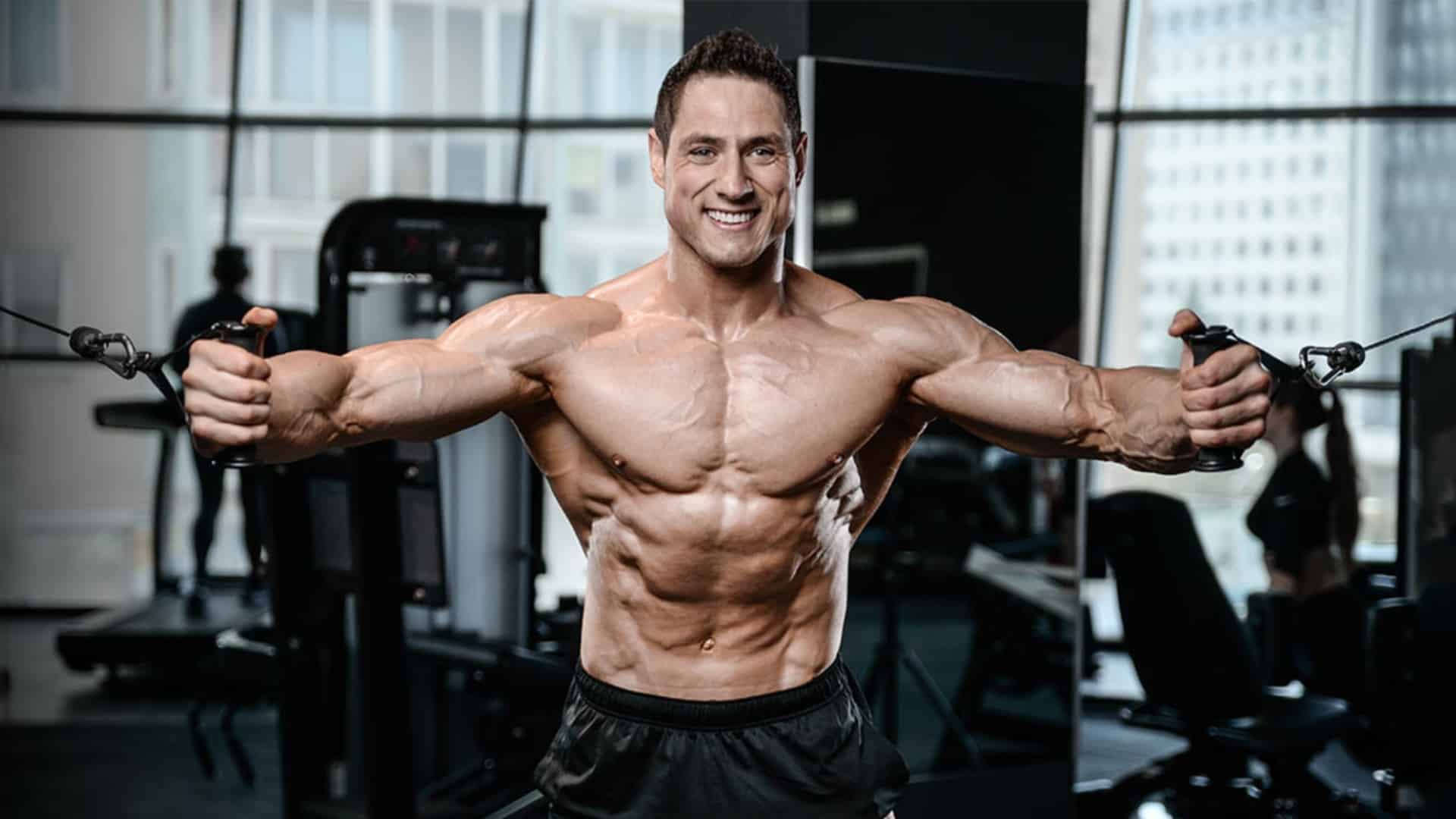
- 14 Best Cable Chest Exercises To Build Mass and Strength
- 1. Cable Crossover (Middle Cable Fly)
- 2. Low Cable Fly (Low to High Cable Fly)
- 3. High Cable Fly (High to Low Cable Fly)
- 4. Standing Cable Chest Press
- 5. Cable Flat Bench Press
- 6. Incline Cable Bench Press
- 7. Decline Cable Bench Press
- 8. Lying Cable Chest Fly
- 9. Incline Cable Fly
- 10. Decline Cable Fly
- 11. Cable Press On Stability Ball
- 12. Cable Incline Fly On Stability Ball
- 13. Single Arm Chest Fly
- 14. Cable Pullover
- Cable Chest Workout Training Tips and Techniques
- 1. Select the Weekly Sets As Your Fitness Level
- 2. Choose a Training Plan As Per Your Goal
- 3. Select Both Compound and Isolation
- 4. Beginner Cable Chest Workout Routine
- 5. For Intermediate
- 6. For Advance
- 7. Add other Chest Workout
- FAQ
- Should I perform cable chest exercises at the beginning or end of my workout?
- Can cable chest exercises replace traditional chest exercises?
- Can cable chest exercises be performed at home?
- Conclusion
- References
14 Best Cable Chest Exercises To Build Mass and Strength
The two main chest exercises you can do with cables are press and fly. Both have many variations.
Here are the 14 best cable chest exercises for building bigger and wider chests. These exercises will hit your pecs from all angles.
1. Cable Crossover (Middle Cable Fly)
If you’re looking for straightforward cable machine chest exercises to add to your routine, cable crossover is a great staple exercise to get you started. It provides constant tension in helping build massive pecs.
Standing cable crossover Exercise helps to develop and define the lower and the Inner pectoral muscles.
Cable provides constant resistance and helps develop the lower and the central chest muscles by providing much-needed stress in the lower and the inner pecs.
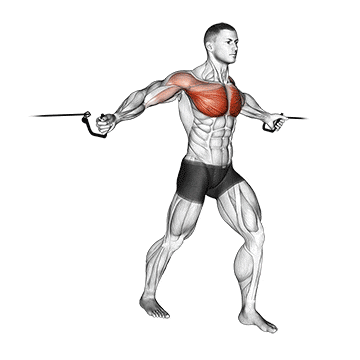
How To Do
- In a standing position, grab and hold the handles of overhead pulleys on both sides.
- Bend slightly forward and extend your arms. Feel a good stretch in your chest muscles.
- Now flex your arms with elbows slightly bent and get a good chest contraction.
- Unlike chest flies, you can cross over the center to get full Pec contraction.
- Breathe in on the relaxation phase and breathe out when contracting, always keeping your head up.
Related Post Lower Chest Cable Exercises for Bigger & Stronger Chest
2. Low Cable Fly (Low to High Cable Fly)
The low-to-high cable chest fly, is the best exercise for training and strengthening the chest and front delt. It primarily targets the upper pectorals by pulling the arms from a low to high angle.
This exercise is highly specialized in isolating the pectoral muscles. Unlike compound exercises such as bench presses, which target the chest, triceps and shoulders, the low Cable Chest Fly solely targets the chest.
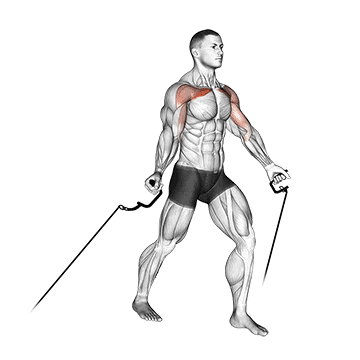
How To Do
- Set both pulleys as low as possible and select the desired weight.
- To keep your balance, stand in a staggered stance. Grab and hold the handles of overhead pulleys on both sides.
- Bend slightly forward and extend your arms, feeling a good stretch in your chest muscles.
- Bend your elbows and pull your hands together in a wide circle in front of you. Stop when your hands touch.
- Breathe out as you lift the handles up and together.
- Slowly lower back to the starting position and repeat for the desired number of repetitions.
Know More: Upper Chest Cable Exercises For Bigger & Stronger Chest
3. High Cable Fly (High to Low Cable Fly)
This exercise is highly specialized in isolating the pectoral muscles. Unlike compound exercises such as bench presses, which target the chest, triceps and shoulders, the High Cable Chest Fly solely targets lower portion of your chest.
This makes it an ideal move to strengthen your lower chest and create an impressive set of pecs.
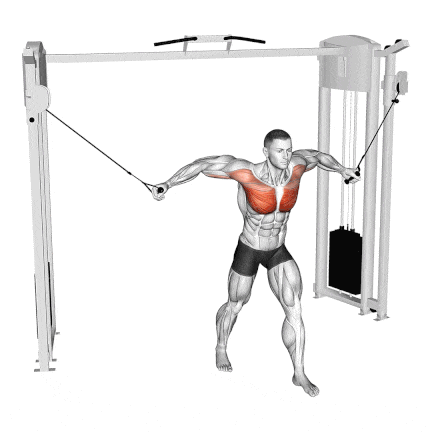
How To Do
- Attach the D-shaped handles to the high pulleys on the cable machine. Ideally, they should be at head height or slightly above.
- Stand in the center of the cable machine with your feet shoulder-width apart.
- Grasp the handles with an overhand grip and step forward to create tension in the cables.
- For balance, you can either place one foot slightly in front of the other in a staggered stance or keep your feet parallel and shoulder-width apart.
- Keep your arms straight and sweep the handles down and in front of you.
- Hold for a count of two at the bottom of the movement, then slowly return to the starting position.
Read More: Lower Chest Cable Exercises For Bigger & Stronger Chest
4. Standing Cable Chest Press
The standing cable chest press is another great exercise for your cable chest workout because it gives you an increased range of motion and contact tension compared to the conventional bench press.
Unlike the bench press, the standing cable chest press requires substantial core work to keep balance and stability.
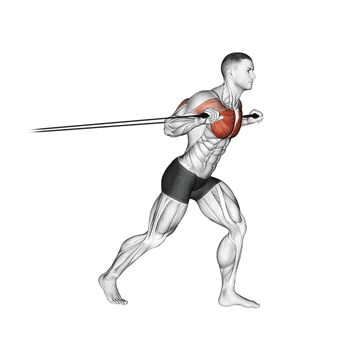
How To Do
- Stand in the center of the two pulleys and grip the stirrups on both sides.
- Ensure your head is up, your core is engaged, and the rest of your body is stable and stationary.
- Step forward a couple of feet in front of the cable machine with one leg in front of the other to form a staggered stance or as comfortable for you.
- Move the handles forward through, extending via your elbows, until your hands meet in the center.
- Briefly squeeze before slowly bringing back to the starting position.
5. Cable Flat Bench Press
A lying cable chest press allows a user to perform a flat bench press without needing a spotter.
The level of constant tension involved with cable chest presses is much greater than that of most traditional free-weight chest presses simply because the strength curve of the cable pulleys more closely matches that of the movement/muscles.
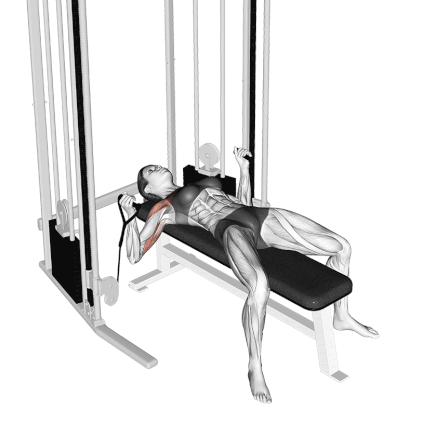
How To Do
- Attach stirrup handles to the low pulleys. Lie on the bench with your feet flat on the floor.
- Position the arms like you would for a shoulder-width grip bench press, starting from the bottom with a 90-degree elbow bend.
- Extend the arms upward until the hands are side by side at the top.
- Reverse the action and repeat for the desired number of repetitions.
6. Incline Cable Bench Press
During dumbbell incline bench presses, the resistance is directly downward, and your triceps brachii take over much of the force from your chest at the top of the press.
In contrast, the incline cable bench press focuses more on your upper pectoralis major throughout the movement because the resistance originates from an angle, and you have to push the stirrups upward and pull them inward at the top of the movement.
Research shows that performing an incline cable fly with a 30 and 45 degree bench angle is the best for the upper chest. Vary the position of the bench to hit different angles of the upper chest.
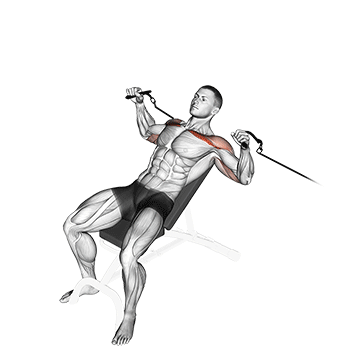
How To Do
- Set the bench at about 30–45 degrees inclined.
- Do not go more upright as the stress shifts to the shoulders rather than the chest area.
- Attach stirrup handles to the low pulleys and lie on the bench with your feet flat on the floor.
- Exhale as you extend your elbows up to move your arms up and inwards until your hands meet.
- Squeeze your chest at the top of the movement and then inhale as you slowly release to the starting position.
7. Decline Cable Bench Press
The decline cable chest press is a variation of the decline dumbbell bench press. It is a great compound exercise for your chest, shoulders, and triceps.
Using cables, as seen in the decline cable chest press, allows one to keep constant tension on the target muscle groups throughout the exercise. Vary the position of the bench to hit different angles of the lower chest.
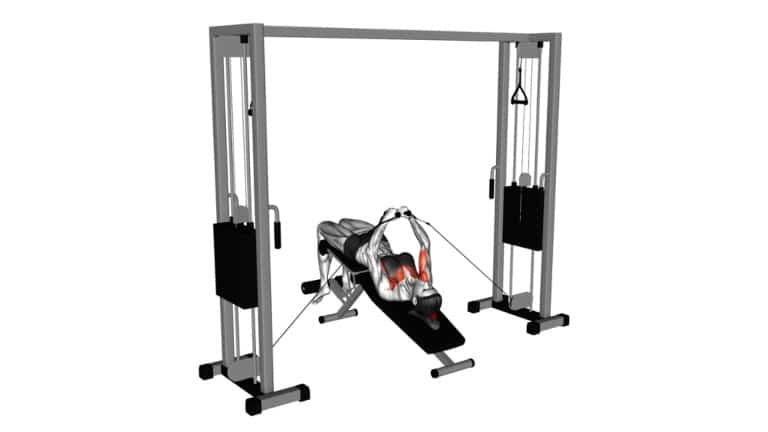
How To Do
- Set a Decline bench at a 30-degree angle. Lie on the bench with your feet flat on the foot pad or the roller.
- Lift your arms straight up from your shoulders and hold the cable handle directly over your chest.
- Once in position, slowly press and extend your arms straight out until you feel the tension in your chest, and hold for a count.
- Bring your arms back toward the mid-line of your body, focusing on using your lower pecs muscles to draw them back together.
8. Lying Cable Chest Fly
Unlike dumbbells or machine fly, the cable system maintains constant tension and isolates the pectoralis major (chest).
The cables allow for a wider arc of movement, enabling a deeper stretch in the pectoral muscles at the bottom of the movement.

How To Do
- Attach stirrup handles to the low pulleys. Lie on the bench with your feet flat on the floor.
- Lift your arms straight up from your shoulders and hold the cable directly over your middle chest.
- Slowly lower the cable attachments outward to your sides.
- Remember to keep your arms slightly bent until your arms are parallel with the ground horizontally,
- Use your pecs muscles to draw your arms back together.
Know More: Cable Fly: Muscle Worked, Alternate, Variations
9. Incline Cable Fly
The incline cable fly is an isolation exercise primarily targeting the upper chest muscles. When you perform incline fly with cables instead of dumbbells, it allows for constant tension and better muscle activation.
It uses a cable machine with an adjustable pulley system and a bench set at an incline angle of around 30–45 degrees.
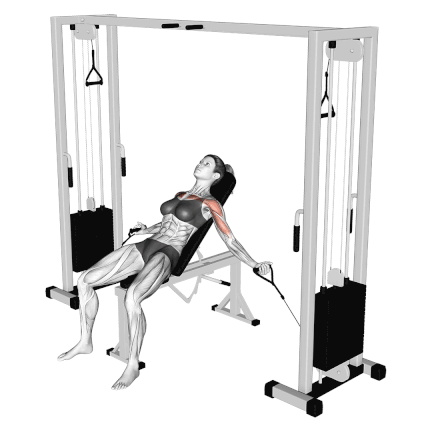
How To Do
- Set an incline bench at a 30-to 45 degree angle.
- Attach stirrup handles to the low pulleys and select a weight that challenges you but allows you to maintain proper form.
- Lay back and get into position while holding the handles at chest height.
- Press the handles to lockout while flexing the pecs and extending the elbows.
- With a slight bend of your elbows, lower your arms out at both sides in a wide arc until you feel a stretch on your chest.
- Return your arms back to the starting position as you squeeze your chest muscles and exhale. Hold the contracted position for a second.
10. Decline Cable Fly
Finally, if you’re looking for one more effective cable chest exercise to train your lower chests, try the decline cable fly.
It is one of the most suitable exercises for isolating the lower chest muscles.
Adding decline cable fly variations to your workout routine can help to target lower chest muscles, and add variety to your workouts.
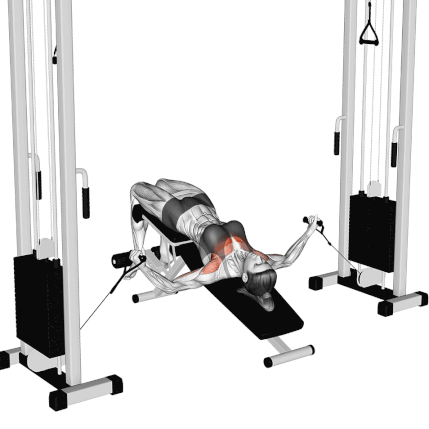
How To Do
- Set a Decline bench at a 30-degree angle. Lie on the bench with your feet flat on the footpad or the roller.
- Pick a weight that you can control, that’s not too light or heavy — find what’s right for you.
- Lift your arms straight up from your shoulders and hold the cable handle directly over your chest.
- Slowly lower your arms to your sides until your wrists reach about shoulder level or slightly above.
- Inhale slowly as the arms return to the starting position while keeping the scapular retraction and elbows bent.
Read More To Know More: Decline Fly: Muscle Worked, Benefits, Form
11. Cable Press On Stability Ball
Cable press on a stability ball is the best exercise that strengthens both your chest and core muscles.
It also increases hip and glute activation and total body stability while increasing muscle activation of the pectorals and hips.
This movement can be done with heavy or light loads to increase triceps, chest, and core strength.
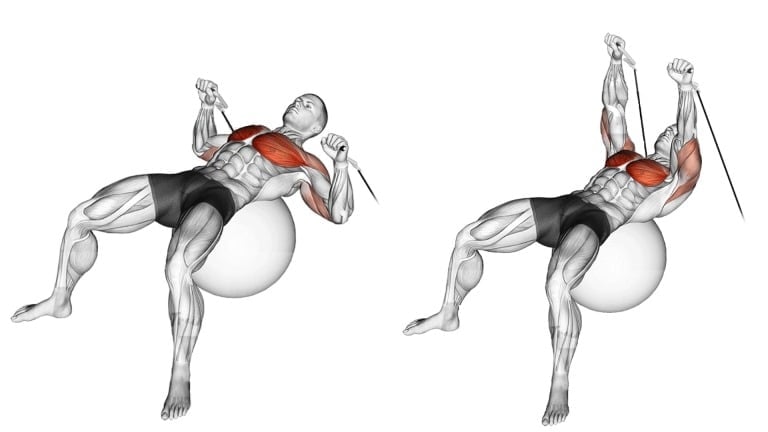
How To Do
- Start by lying on a ball and holding two cable handles in each hand.
- Slowly walk your feet out in front of you so your legs are extended, your knees bent, and your back is flat in the middle of the ball.
- Keep your head and spine neutral, raise the hips, and tighten your core.
- Move the handles forward and extend your elbows until your hands meet in the middle.
- Hold on to this position for a few seconds, then return to the starting position.
- Perform the exercise properly and ensure they don’t lose their balance and fall.
12. Cable Incline Fly On Stability Ball
If you’re looking for a way to get more creative with your cable chest workout, why not try cable Incline Fly On a Stability Ball? This exercise may seem easy because you’re lying back on the ball, but there’s still a lot going on when you do it.
This is a difficult exercise but extremely important to improve stability and control.
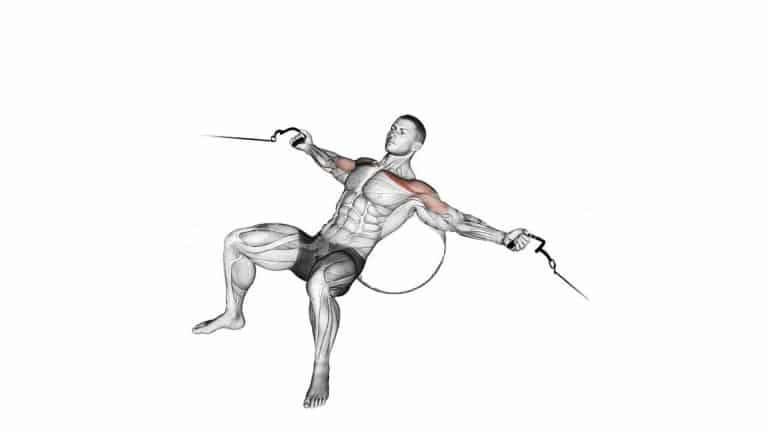
How To Do
- Start off by sitting on an exercise ball, gripping cable handles in each hand.
- Slowly roll down on the exercise ball, ensuring that your head and neck are on the ball and your feet are planted on the floor ahead.
- Lift up with the cables and bring them straight up above your chest, squeezing throughout the entire motion.
- Perform the exercise properly and ensure they don’t lose their balance and fall.
- For a brief period of time, maintain this position and then return to the initial position.
13. Single Arm Chest Fly
When doing a chest workout with a cable machine, you can add plenty of single-arm exercises to correct potential imbalances.
The one-arm fly is a unilateral variation of the fly. It is used by those who want to focus on the inner chest.
During Exercise, emphasis is placed on bringing the resistance further across the body and past the midline, thus extending the range of motion to force an intense peak contraction in the inner pec.
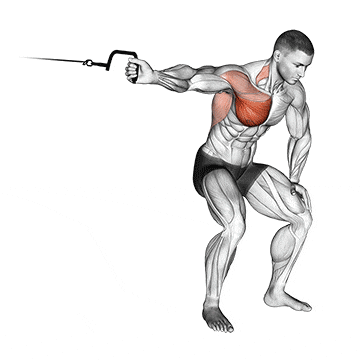
How To Do
- Set the pulleys to a high position, select the resistance, and take a handle in one hand.
- Extend your arm and have a slight bend in your elbow.
- Slowly pull your hand to the midline of your chest.
- Hold for a second, and return to the starting position to complete one rep.
- Keep a controlled motion and avoid jerky movements.
14. Cable Pullover
The lying cable pullover is a great alternative to the barbell or dumbbell pullover.
Cable Pullovers are the best exercise for building a strong rib cage and serratus anterior muscle, which together form a complete chest and back. Pullovers work directly on the serratus anterior muscle to develop the back.
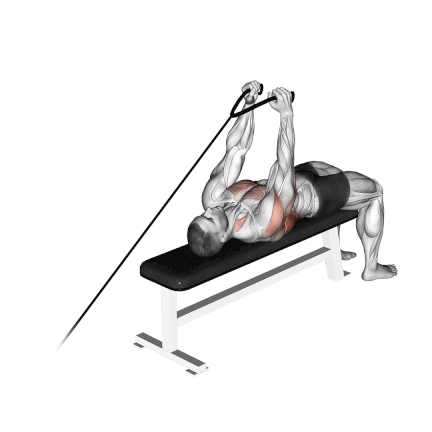
How To Do
- Set up the bench in front of a low pulley cable machine, leaving about 2–3 feet between it and the machine.
- Lay down on the bench on your back with your head up near the end closest to the cable machine. Grasp a rope with both hands.
- Maximum stretching ensures the greatest expansion of the rib cage.
- Keep your arms straight and slowly pull your hands up and across the top of your head.
- Pause, and then lower the weight back to the starting position. Repeat for desired reps.
Cable Chest Workout Training Tips and Techniques
When doing chest exercises using cables, it is important to remember that the exercises should target both the upper and lower portions of the chest.
1. Select the Weekly Sets As Your Fitness Level
Of course, the number of sets will be determined based on your fitness journey, but here is a great starting point:
- Beginners: ~10 sets per week.
- Intermediate: ~15 sets per week.
- Advanced: ~20 sets per week.
When a certain amount of volume stops being effective and your progress stalls, you can add sets to increase volume and use that as a driver of renewed progress.
2. Choose a Training Plan As Per Your Goal
The Cable chest exercises listed will be performed with moderate loads and repetitions to emphasize both muscular hypertrophy (muscle growth) and muscular endurance.
- For muscle endurance: Aim for 3–4 sets of 12–15 reps, with moderate resistance of at least 50 to 70% of your 1RM.
- For muscle strength: Aim for 3–5 sets and 3 to 6 reps with heavy weight, i.e., at 85%, 1 RM loads.
- For muscle hypertrophy (increased muscle size): Aim for 3–4 sets of 8–12 reps, with moderate to heavy resistance of 70 to 85% of your 1RM.
It is always best to start with a lower number of reps and sets, and then gradually increase as your strength improves.
3. Select Both Compound and Isolation
Including compound and isolation exercises in your routine is important to maximize your gains.
Compound movements improve strength and mass, while isolation exercises refine specific areas for a balanced and sculpted chest.
Change the body position, weight load, and attachments to hit all pecs muscles from different angles and motions.
4. Beginner Cable Chest Workout Routine
It will be important to perform each set to muscular fatigue. In other words, the last few repetitions should be difficult, but you should be able to maintain ideal form, posture, and technique throughout the entire set.
| Exercise | Sets | Reps | Rest |
|---|---|---|---|
| Standing Cable Chest Press | 3-4 | 8-10 | 60-90 seconds |
| Cable Incline Bench Press | 3-4 | 8 | 60-90 seconds |
| Crossover | 4 | 8-10 | 60-90 seconds |
5. For Intermediate
| Exercise | Sets | Reps | Rest |
|---|---|---|---|
| Flat Cable Bench Press | 4 | 8-10 | 45-60 seconds |
| Low Cable Fly | 3-4 | 10-12 | 45-60 seconds |
| Cable Pullover | 4 | 8-10 | 45-60 seconds |
| Cable Crossovers | 3 | 10-12 | 45-60 seconds |
6. For Advance
Here’s a sample cable-only workout plan for advanced:
| Exercise | Sets | Reps | Rest |
|---|---|---|---|
| Cable Chest Press | 3-4 | 10-12 | 30-45 seconds |
| Low-to-High Cable Flyes | 3-4 | 10-12 | 30-45 seconds |
| High-to-Low Cable Flyes | 3-4 | 8-10 | 30-45 seconds |
| Cable Crossovers | 3 | 10-12 | 30-45 seconds |
| Single-Arm Cable Chest Press | 3 | 12-15 | 30-45 seconds |
7. Add other Chest Workout
It’s a good idea to add a variety of exercises to your chest workout routine to target the muscle from different angles and provide overall muscle growth.
Be smart: Don’t limit yourself to cable chest exercises. Please take advantage of their benefits and supplement them with other chest exercises when needed.
Cable workouts can be easily incorporated into any training program and are particularly effective when used alongside dumbbells, barbells, machines, and bodyweight to build the biggest, strongest arm possible.
FAQ
Should I perform cable chest exercises at the beginning or end of my workout?
The cable chest exercises can be performed at the beginning or end of your workout, depending on your goals.
If you want to focus on chest training, consider doing cable chest exercises at the beginning of your workout.
Can cable chest exercises replace traditional chest exercises?
Cable chest exercises are a good addition to your workout routine, but they shouldn’t replace traditional chest exercises completely.
Try to include different exercises to target different areas of the chest muscles and create a well-rounded workout routine.
Can cable chest exercises be performed at home?
Yes, cable chest exercises can be done at home if you have a cable machine or resistance bands.
Many chest exercises, such as push-ups and chest dips, can also be performed without any equipment.
Conclusion
Doing the chest workout using cable machine exercises, will give your chest a complete workout, focusing on equal parts on each section of your pectorals for improved performance and aesthetics.
This best cable chest exercise and workout plan is highly recommended for anyone interested in building body strength and gaining muscle.
Let us know your favorite cable chest exercises in the comment section below!
Thanks for reading!
References
- Schoenfeld B.J., Ogborn D., Krieger J.W. Dose-response relationship between weekly resistance training volume and increases in muscle mass: A systematic review and meta-analysis. J. Sports Sci. 2017;35:1073–1082. doi: 10.1080/02640414.2016.1210197.
- Signorile, Joseph F.1,2; Rendos, Nicole K.1; Heredia Vargas, Hector H.1; Alipio, Taislaine C.1; Regis, Rebecca C.1; Eltoukhy, Moataz M.1; Nargund, Renu S.1; Romero, Matthew A.1. Differences in Muscle Activation and Kinematics Between Cable-Based and Selectorized Weight Training. Journal of Strength and Conditioning Research 31(2):p 313-322, February 2017. |
- Muyor, J. M., Rodríguez-Ridao, D., & Oliva-Lozano, J. M. (2023). Comparison of Muscle Activity between the Horizontal Bench Press and the Seated Chest Press Exercises Using Several Grips. Journal of Human Kinetics, 87, 23–34.
- Signorile, J. F., Rendos, N. K., Heredia Vargas, H. H., Alipio, T. C., Regis, R. C., Eltoukhy, M. M., Nargund, R. S., & Romero, M. A. (2017). Differences in Muscle Activation and Kinematics Between Cable-Based and Selectorized Weight Training. Journal of strength and conditioning research, 31(2), 313–322. https://doi.org/10.1519/JSC.0000000000001493

Manish is a NASM-certified fitness and nutrition coach with over 10 years of experience in weight lifting and fat loss fitness coaching. He specializes in gym-based training and has a lot of knowledge about exercise, lifting technique, biomechanics, and more.
Through “Fit Life Regime,” he generously shares the insights he’s gained over a decade in the field. His goal is to equip others with the knowledge to start their own fitness journey.

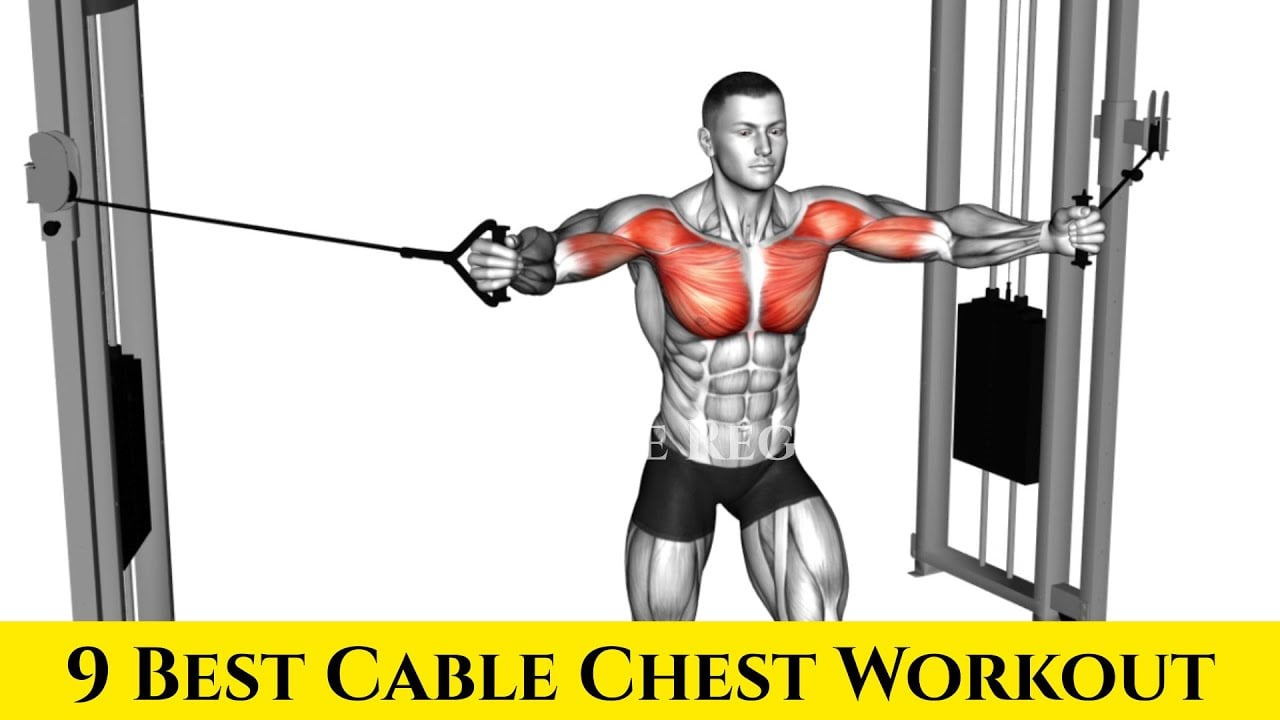
I found the article very informative. Keep posting such articles on health and fitness. It really motivates people like me.